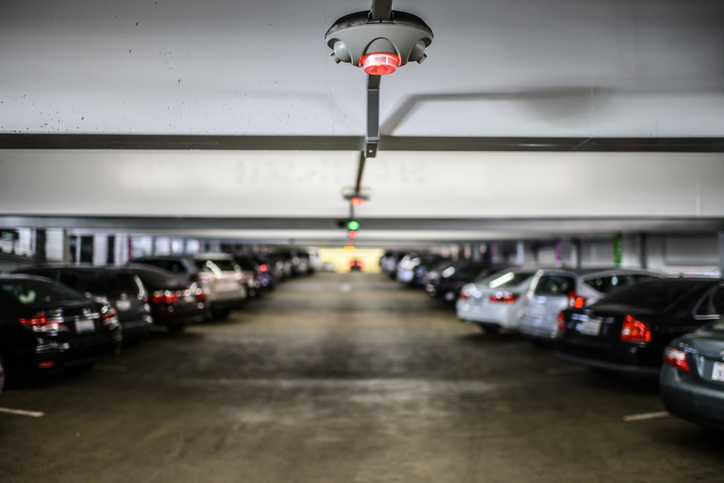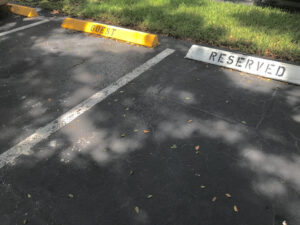Technology is always changing and evolving, and the implementation of new technologies in parking management can create greater efficiency, more streamlined solutions, and additional capabilities for convenience and a better overall experience. From pavement sensors to license plate recognition (LPR), RFID, and QR codes, new parking technologies are revolutionizing traditional parking infrastructure, removing burdens, and providing unparalleled convenience.
Pavement Sensors
Pavement sensors play a crucial role in modern parking management systems, providing real-time data on parking space occupancy and usage patterns. These sensors are typically embedded in the pavement of parking spaces and communicate wirelessly with a centralized parking management system. Here are some key aspects of pavement sensors for parking management:
- Technology and Functionality:
Pavement sensors utilize various technologies, including infrared, ultrasonic, magnetic, or optical sensors, to detect the presence or absence of vehicles in parking spaces. These sensors are typically ruggedized to withstand the stresses of vehicular traffic and changing weather conditions. When a vehicle occupies a parking space, the sensor detects the change in status and transmits the information to a centralized control system.
- Real-Time Parking Data:
One of the primary advantages of pavement sensors is their ability to provide real-time data on parking space occupancy. By continuously monitoring the status of individual parking spaces, these sensors enable parking operators and drivers to access up-to-date information on available parking spots. This real-time data can be utilized to optimize parking utilization, reduce congestion, and enhance the overall parking experience for drivers.
- Accuracy and Reliability:
Pavement sensors are designed to deliver accurate and reliable parking occupancy information, ensuring minimal errors in detection. Advanced sensor technologies, coupled with sophisticated algorithms, help mitigate false readings caused by factors such as shadows, debris, or minor fluctuations in sensor performance. High levels of accuracy are essential for ensuring the effectiveness of parking management strategies and maximizing the utilization of parking resources.
- Wireless Connectivity and Integration:
Pavement sensors are typically equipped with wireless communication capabilities, allowing them to transmit data to a centralized parking management system in real-time. This wireless connectivity enables seamless integration with other components of the parking infrastructure, such as digital signage, mobile apps, or payment platforms. By integrating pavement sensor data with other systems, parking operators can deliver a more comprehensive parking experience and optimize operational efficiency.
- Maintenance and Scalability:
Pavement sensors require minimal maintenance once installed, thanks to their durable construction and robust design. However, periodic inspections may be necessary to ensure proper functioning and address any issues that arise. Additionally, pavement sensors are scalable, meaning they can be deployed across various parking facilities, ranging from on-street parking spaces to multi-level parking garages. This scalability allows parking operators to tailor their parking management solutions to suit specific locations and requirements.
- Cost-Effectiveness and ROI:
While the initial investment in pavement sensor technology may be relatively high, the long-term benefits often justify the cost for large scale parking applications such as malls, airports, and large scale parking structures. By improving parking efficiency, reducing traffic congestion, and enhancing the overall user experience, pavement sensors can generate significant returns on investment for parking operators and city authorities. Moreover, the data collected by pavement sensors can inform strategic decision-making and help optimize revenue generation through dynamic pricing models and targeted marketing initiatives.
Pavement sensors are essential components of modern parking management systems, providing accurate, real-time data on parking space occupancy and usage. By leveraging advanced sensor technologies, wireless connectivity, and integration capabilities, pavement sensors enable parking operators to optimize parking utilization, improve traffic flow, and enhance the overall efficiency of urban parking infrastructure.
License Plate Recognition (LPR)
License Plate Recognition (LPR) technology, also known as Automatic License Plate Recognition (ALPR), is a sophisticated system designed to automatically capture and interpret license plate information from vehicles entering or exiting parking facilities. LPR technology has become increasingly prevalent in parking management systems due to its ability to enhance security, streamline access control, and automate billing processes. Here’s a closer look at the key aspects of License Plate Recognition technology for parking management:
- Detection and Capture:
LPR systems consist of specialized cameras equipped with optical character recognition (OCR) software capable of capturing high-resolution images of license plates. These cameras are strategically positioned at entry and exit points of parking facilities to ensure comprehensive coverage. When a vehicle approaches, the LPR camera captures an image of the license plate, even in varying lighting conditions or at high speeds. The OCR software then processes the image to extract alphanumeric characters from the license plate.
- Data Processing and Recognition:
Once the license plate image is captured, the OCR software analyzes the extracted characters to identify the license plate number. Advanced algorithms and pattern recognition techniques enable LPR systems to accurately interpret license plate information, even in cases of obscured or partially damaged plates. Additionally, LPR technology can recognize license plates from different jurisdictions and formats, making it versatile and adaptable to various geographic locations.
- Access Control and Security:
One of the primary applications of LPR technology in parking management is access control and security. By automatically identifying vehicles entering and exiting parking facilities, LPR systems can enforce access restrictions based on predefined criteria. For example, authorized vehicles can be granted seamless entry, while unauthorized vehicles trigger alerts or are denied access. Moreover, LPR technology enhances security by quickly identifying stolen vehicles, vehicles with outstanding warrants, or other suspicious activity, allowing parking operators to take appropriate measures in real-time.
- Automated Billing and Payment:
LPR technology streamlines billing and payment processes by automating the identification of vehicles and associating them with corresponding parking transactions. Instead of relying on physical tickets or access cards, LPR systems automatically link license plate information to parking duration, rates, and payment records. This automation reduces the need for manual intervention, minimizes errors, and improves operational efficiency for parking operators. Additionally, LPR technology facilitates seamless integration with mobile payment platforms, enabling drivers to pay for parking electronically without the hassle of traditional payment methods.
- Data Analytics and Reporting:
LPR systems generate valuable data insights that can inform parking management strategies and decision-making processes. By analyzing historical parking data, LPR technology helps parking operators identify usage patterns, peak demand periods, and revenue trends. This data can be leveraged to optimize parking pricing, allocate resources more effectively, and enhance overall operational performance. Additionally, LPR technology enables the generation of comprehensive reports and analytics dashboards, providing stakeholders with actionable insights into parking facility performance and customer behavior.
- Privacy and Data Security:
Concerns about privacy and data security are paramount when implementing LPR technology. Parking operators must adhere to strict data protection regulations and implement robust security measures to safeguard sensitive information collected by LPR systems. This includes encryption of data transmission, secure storage practices, and adherence to data retention policies. Additionally, transparency and accountability in data handling practices are essential to build trust among users and address privacy concerns.
License Plate Recognition technology plays a pivotal role in modern parking management systems, offering a wide range of benefits including enhanced security, streamlined access control, automated billing processes, data analytics capabilities, and improved operational efficiency. Since this type of service has a relatively low price tag and can be directly integrated with parking software like Reliant Parking for added convenience, it is being used increasingly by more HOAs and multifamily parking applications. By leveraging advanced OCR algorithms, real-time data processing, and seamless integration with other parking infrastructure components, LPR technology enables parking operators to deliver a more convenient, secure, and efficient parking experience for drivers while optimizing revenue generation and resource allocation.
RFID Tags
RFID (Radio Frequency Identification) tags are small electronic devices that consist of a microchip and an antenna. These tags emit radio waves and can store and transmit data wirelessly when activated by an RFID reader. In the context of parking management, RFID tags are used to uniquely identify vehicles and facilitate various aspects of parking operations. Here’s a deeper dive into RFID tags and their role in parking management:
- Vehicle Identification:
RFID tags are commonly used for vehicle identification in parking facilities. Each vehicle is equipped with an RFID tag, typically affixed to the windshield or another easily accessible location. The RFID tag contains a unique identifier associated with the vehicle, such as a serial number or license plate number. When a vehicle enters or exits the parking facility, RFID readers installed at entry and exit points detect the RFID tag’s presence and retrieve the associated identification information.
- Access Control:
RFID tags play a crucial role in access control systems for parking facilities. By associating RFID tags with authorized vehicles or parking permits, parking operators can regulate access to restricted areas or designated parking zones. When an authorized vehicle approaches a gated entry or exit point, the RFID reader scans the RFID tag and verifies its validity against a database of authorized vehicles. If the RFID tag matches an entry in the database, the gate is automatically opened, allowing the vehicle to enter or exit the parking facility.
- Automated Payments:
RFID tags streamline payment processes by enabling automated billing and payment for parking services. Parking operators can link RFID tags to customer accounts or payment methods, allowing for seamless transactions when vehicles enter or exit the parking facility. Instead of requiring drivers to stop and pay at a payment kiosk or toll booth, RFID readers automatically record the vehicle’s entry and exit times and calculate the corresponding parking fees based on predefined rates. This automated billing system enhances convenience for drivers and improves operational efficiency for parking operators.
- Vehicle Tracking and Monitoring:
RFID tags enable real-time tracking and monitoring of vehicles within parking facilities. By deploying RFID readers at strategic locations throughout the parking facility, parking operators can track the movement of vehicles as they enter, exit, and move within the facility. This tracking capability provides valuable insights into parking utilization, occupancy levels, and traffic flow patterns, allowing operators to optimize parking operations, allocate resources efficiently, and identify areas for improvement.
- Integration with Parking Management Systems:
RFID tags are seamlessly integrated with parking management systems, allowing for centralized control and management of parking operations. RFID readers communicate with a centralized parking management system, which maintains a database of RFID tag information, customer accounts, and transaction records. This integration enables parking operators to efficiently manage access control, billing, enforcement, and reporting processes, ensuring a seamless and cohesive parking experience for drivers and operators alike.
- Security and Data Privacy:
Security and data privacy are critical considerations when implementing RFID technology in parking management. To protect sensitive information stored on RFID tags, parking operators must employ encryption techniques and secure authentication protocols. Additionally, strict access controls and data encryption measures should be implemented to safeguard RFID tag data stored within parking management systems. By prioritizing security and data privacy, parking operators can instill trust and confidence among drivers and mitigate the risk of unauthorized access or data breaches.
RFID tags play a vital role in modern parking management systems, facilitating vehicle identification, access control, automated payments, vehicle tracking, and integration with parking management systems. By leveraging RFID technology, parking operators can enhance operational efficiency, improve the parking experience for drivers, and optimize the utilization of parking resources within their facilities. RFID technology has become extremely popular for use in multifamily parking situations.
QR Codes
QR (Quick Response) codes have emerged as a versatile tool in parking management systems, offering a convenient and efficient way to facilitate various aspects of parking operations. Here’s a closer look at how QR codes are used in parking management:
- Ticketless Entry and Exit:
QR codes enable ticketless entry and exit in parking facilities, eliminating the need for physical parking tickets or access cards. When a vehicle arrives at the parking facility, the driver can scan a QR code displayed at the entry gate using a smartphone or a dedicated QR code scanner. The QR code contains information such as a unique identifier for the parking session or the vehicle’s license plate number. Upon successful scanning, the gate automatically opens, granting the vehicle access to the parking facility. Similarly, when exiting the facility, the driver can scan another QR code at the exit gate to complete the parking session.
- Mobile Payment Integration:
QR codes are often integrated with mobile payment platforms, allowing drivers to conveniently pay for parking using their smartphones. After scanning the QR code at the entry gate to initiate the parking session, the driver can use a mobile app to select the desired duration of parking and make a payment. The app generates a unique QR code or transaction ID, which is then scanned at the exit gate to verify payment and authorize exit from the parking facility. This seamless integration of QR codes with mobile payment platforms enhances the convenience and flexibility of parking payment options for drivers.
- Reservation Systems:
QR codes are utilized in parking reservation systems to facilitate pre-booked parking spaces. When a driver makes a parking reservation through a website or mobile app, a QR code is generated as a confirmation of the booking. Upon arrival at the parking facility, the driver can scan the QR code at the entry gate to access the reserved parking space. This integration of QR codes with reservation systems streamlines the check-in process for pre-booked parking customers and helps ensure a smooth parking experience.
- Dynamic Information Display:
QR codes can be used to provide dynamic information to drivers within parking facilities. For example, QR codes displayed on signage or parking space markers can link to real-time updates on parking availability, rates, and facility information. Drivers can scan these QR codes to access up-to-date information on available parking spaces, navigate within the parking facility, or receive notifications about special promotions or events. This enhances the overall parking experience and helps drivers make informed decisions.
- Enforcement and Compliance:
QR codes can also be utilized for enforcement and compliance purposes in parking management. For example, parking enforcement officers equipped with handheld devices can scan QR codes displayed on vehicles to verify parking permits or check for parking violations. Additionally, QR codes can be integrated into parking permits or validation vouchers to streamline the verification process and ensure compliance with parking regulations.
- Integration with Loyalty Programs:
QR codes can be integrated with parking loyalty programs to reward frequent parkers or incentivize repeat visits. Drivers can earn loyalty points or discounts by scanning QR codes displayed at entry gates or making payments through designated mobile apps. This encourages customer loyalty and engagement while providing additional benefits for regular parking customers.
QR codes offer a wide range of applications in parking management, including ticketless entry and exit, mobile payment integration, reservation systems, dynamic information display, enforcement and compliance, and integration with loyalty programs and software solutions such as Reliant Parking. By leveraging QR code technology, parking operators can enhance the efficiency, convenience, and overall user experience within their parking facilities.
Staying on top of new technologies and key innovations in the parking management space is crucial to the success of everyone involved. However, while some of the more complex solutions offer various significant benefits, their cost can be a barrier to entry for small-scale parking operations, and they are most often implemented on a large-scale level (such as with malls and retail operations).
At Reliant Parking, we’re always looking for new ways to integrate new advancements in transformative technology into our parking management system for a more powerful solution to common parking problems.





